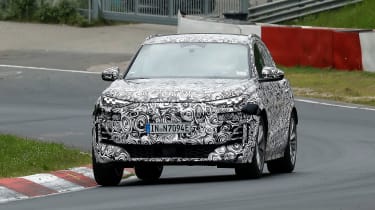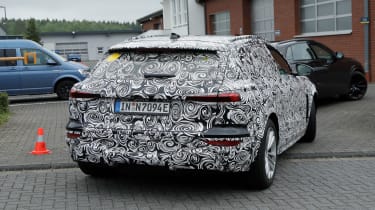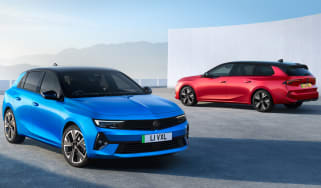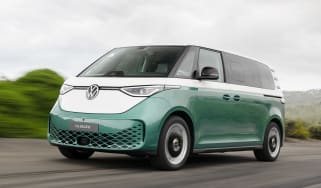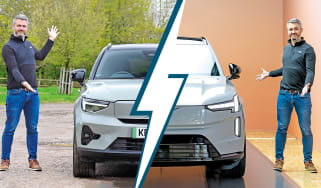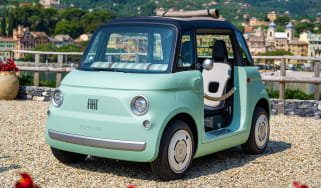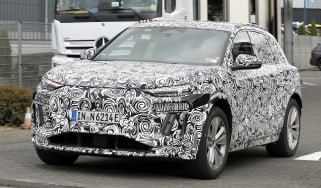New Audi Q6 e-tron to sit on new PPE platform
The Q6 e-tron will feature the latest VW Group technology
Audi appears to be throwing plenty of weight behind its upcoming Q6 e-tron. The electric SUV will be the first car in the Volkswagen Group to use the advanced new PPE platform and our latest spy shots also reveal some new design details which could hint at a range-topping RS variant.
The car will be available in both ‘Sportback’ coupe-SUV and regular SUV guises and Audi has previously given us official images of the “production-oriented Q6 e-tron prototype” testing. The car in these new spy shots, however, is a version we haven’t seen before.
The biggest change is the air duct behind the front wheel - a design trait similar to the one seen on the Audi RS 3. The headlights have a new chequered flag motif and the front bumper and rear diffuser are entirely different to those on other Q6 e-tron test cars - all of these changes point towards this car being the hot RS Q6 e-tron.
Both the standard car and the RS model will feature a closed-off, textured front grille flanked by a pair of dual LED headlights. Beneath we can see side air intakes with strakes. A full-width light bar with a signature similar to the one on the e-tron GT will mark out the Q6’s rear end.
We’ve also caught the Q6 e-tron Sportback coupe-SUV model testing and while it looks identical at the front, the more aerodynamic silhouette of the Sportback model could liberate a few extra miles of range over the standard SUV. Boot space will obviously take a hit, however.
The Audi Q6 e-tron will be positioned between the Q4 e-tron and the recently updated Q8 e-tron SUV. This means the Q6 model will be pitched as a rival to the Tesla Model Y, BMW iX3 and Nissan Ariya. We expect the Q6 will be comparable in external dimensions to the combustion-engined Q5, but with a longer wheelbase and increased passenger space enabled by the new platform.
Inside, the car is likely to adopt the new 11.6-inch central touchscreen used in the Q4 e-tron. However, the design could be different due to the platform, and also to separate both models in terms of price and positioning.
The PPE architecture found underneath the Q6 e-tron will be shared with the next-generation Porsche Macan, which is due to be launched in 2023 as a full EV sitting alongside the existing, petrol-powered Macan. Despite both the Q6 and new Macan sharing similar hardware and software, they will be visually separate both inside and out.
The PPE platform is an evolution of the J1 platform found under the e-tron GT four-door, as well as the Porsche Taycan. That means it’ll have an 800-volt electrical architecture, enabling super-fast DC charging at a rate of up to 350kW.
Audi also says the platform will allow the EV’s battery pack to charge from five to 80 per cent capacity in around 25 minutes. A shorter charge using the fastest possible DC rapid charger can also add 186 miles of range in just 10 minutes.
It remains to be seen what size and type of battery pack Audi will use in the Q6 e-tron, but the firm says the PPE (Premium Platform Electric) platform is capable of covering more than 700km (around 430 miles) when powering the more aerodynamic A6 e-tron concept. The slightly blunter surfacing on the SUV will dent the range, but a figure of more than 380 miles should be achievable.
Given the relationship to the e-tron GT under the Q6’s bodywork, we should also see that car’s 469bhp (or 523bhp with overboost engaged) four-wheel drive powertrain transfer over. More affordable, lower-powered single-motor variants are also likely, while at the other end of the range Audi’s RS division could line-up a more performance-focused model. That’ll probably use the same 636bhp powertrain as the RS e-tron GT.
The Q6 e-tron will go into production at Audi’s Ingolstadt factory this year, which the brand is converting to an all-electric assembly line, removing the existing equipment that produces the brand’s A3 family hatch and replacing it with production facilities to accommodate the PPE platform.
This also includes the development of an in-house battery assembly facility. The Volkswagen Group (Audi’s parent company) has already signed a trio of partnerships to secure the raw materials and development processes required for its next-generation battery packs up to 2030.
Following the Q6 e-tron, Audi confirmed that its first “Project Artemis” model will launch in 2024. The car will be aimed at the luxury sector, spearheading Audi’s development of future electronic vehicle architecture, technology and operating systems.
Now read about the all-new Q8 e-tron…

